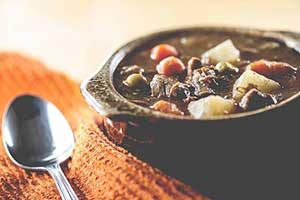Slow cookers have come into their own in recent years and developing a knack for how to use them only comes, for most, with trial, error and time. I’ve had my slow cooker for upwards of two years now and as a family that regularly feeds six (plus friends and relatives) it has been a blessing and a learning curve rolled into one. To help you with your learning curve, I hope you enjoy the read as I share with you my top tips to help you use your slow cooker.
 Preparing to Slow Cook
Preparing to Slow Cook
- For quick and easy clean up, use a cooking spray or a little oil to the inside of the walls and the base of the pot before adding your ingredients.
- Just like any recipe, be sure to read all the instructions before preparing food for the slow cooker. Believe me, I have had my share of oopsie’s!
Converting Recipes
- For every hour of cooking time in a traditional oven you will need to allow either 4-6 hours on ‘high’ or 8-10 hours on ‘low’ in the slow cooker.
- Cheaper and tougher cuts of meat come out better when on ‘low’ and giving them time to become tender. Factor in extra time for those meat cuts that may need it.
- Slow cookers retain moisture by the collection and return of condensation collected on the lid. You may need to reduce the amount of liquid for recipes where rice or pasta are not being used. Recipes with rice and pasta are also the only ones that can truly ‘burn dry’ by absorbing all the liquid in the recipe.
Use of Your Slow Cooker
- A slow cooker can take up to 20 minutes to come back up to temperature after having the lid removed. Unless your recipe calls for stirring then keep a lid on it! Also, never use the slow cooker without the lid in place.
- Refer to the manufacturer’s information to find out where the heating element is located. Using slow cookers with elements in the side means that your recipe should not need stirring. If the element is at the bottom then stirring every couple of hours is an idea ensuring that you add fifteen to twenty minutes each time you remove the lid.
- Most slow cookers have two temperature settings: ‘low’ is just below boiling point and ‘high’ above that allowing your recipe to simmer.
- Slow cookers work best when filled from sixty to seventy-five percent capacity. Be sure to adapt your recipe so that it fills at least that amount of your pot. Refer to the manufacturer’s instructions for information on the minimum fill capacity.
Preparing Ingredients
- Dry beans take longer to cook if they are not prepared first. Soaking the beans overnight can reduce their cooking time by up to 75 per cent.
- Do not add meats that are still frozen to your slow cooker as they may not cook thoroughly. This is not a problem with vegetables though!
- Dense vegetables such as potato and carrots take longer to cook than meat. Layer these under any meat to ensure they are cooked to perfection also.
Retaining Colour and Flavour
- If you have a dish that is being cooked over several hours be sure to check on the flavours created by herbs and spices. Using such cooking long cooking times means that herbs and spices may need to be ‘topped up’ as they compete the flavoursome main ingredients. Alternatively, you may wish to add fresh herbs within the last hour of cooking so they are fresh and full flavoured.
- Slow cooked vegetables will change in appearance as time passes. To maintain the attractiveness of a dish dress it up with beautiful garnishes of fresh salad vegetables, herbs, or sour cream sprinkled with some bright spices.
Tips for Perfection
- Soups and stews need to ability to simmer on ‘high’ without spilling over the edge of the dish. To achieve this be sure to leave approximately five centimetres (or two inches) space from the top of the cooker.
- Thickening the liquid in the slow cooker can be easily achieved by mixing a tablespoon of corn flour with two tablespoons of water. When adding it to the slow cooker be sure to stir it through well to prevent lumps forming and within an hour it should start to thicken to a gravy-style consistency.
- A long cooking time can cause dairy products to curdle so it is an idea to consider adding your milk, cream, sour cream or cheese near the end of the cooking time.
Left with Left Overs?
Once your slow cooked dish is cooked be sure to pack away left overs promptly to avoid the build up of bacteria. Store remaining food in shallow dishes or zip lock bags that can be laid flat for quick chilling and refrigerate or freeze as desired. Do not heat your left over food in your slow cooker.